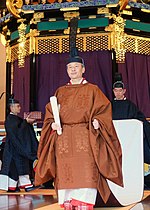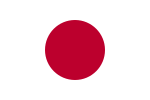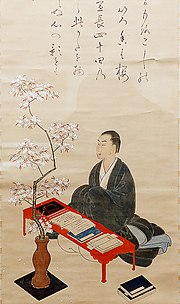Kodansha (1983). "Man'yoshu". Kodansha Encyclopedia of Japan. Kodansha. Nakanishi, Susumu (1985). Man'yōshū Jiten (Man'yōshū zen'yakuchū genbun-tsuki...
34 KB (3,422 words) - 08:18, 14 October 2024
ISBN 978-1-906876-20-3. Nakanishi, Susumu (8 August 1978). Man'yōshū Zen'yakuchū Genbun-tsuki (Ichi) 万葉集 全訳注原文付(一) [Man'yōshū: a Full Translation and Commentary Containing...
39 KB (3,406 words) - 12:11, 7 November 2024
The Shinsen Man'yōshū (新撰万葉集, "Newly Compiled Man'yōshū"), also called the Kanke Man'yōshū (菅家万葉集, "Sugawara no Michizane's Man'yōshū"), is a privately...
3 KB (254 words) - 02:26, 9 February 2021
the Man'yōshū. The pattern is 5-7-5-7-7-7. Sedōka: The Man'yōshū and Kokinshū recorded this form. The pattern is 5-7-7-5-7-7. Katauta: The Man'yōshū recorded...
22 KB (2,544 words) - 19:33, 7 February 2024
Literature: From the Man'yōshū to Modern Times. Surrey, UK: Japan Library. p. 37. ISBN 1-873410-48-4. Vovin, Alexander (2009). Man'yōshū (Book 15): A New...
10 KB (1,063 words) - 08:51, 11 November 2024
Japanese poetry (section Man'yōshū anthology)
most significant in the Man'yōshū, he rightly has a place as one of the most outstanding poets in Japanese literature. The Man'yōshū also included many female...
49 KB (6,798 words) - 13:23, 22 August 2024
little known about Tsukuyomi that even their sex is unknown. Still, in Man'yōshū, Tsukuyomi's name is sometimes rendered as Tsukuyomi Otoko (月讀壮士, "moon-reading...
5 KB (560 words) - 00:25, 2 September 2024
Man'yōshū Volume 4, Iwanami Shoten, ISBN 4-00-240004-2 Takagi, Ichinosuke; Gomi, Tomohide; Ōno, Susumu (1962), Nihon Koten Bungaku Taikei: Man'yōshū Volume...
80 KB (9,031 words) - 20:02, 17 November 2024
The Man'yōshū, an 8th-century Japanese anthology of waka, survives in a number of manuscripts dating to the 11th century and later. The surviving manuscripts...
13 KB (1,157 words) - 14:24, 26 December 2021
cutting-edge foreign drama, known for its famous writing, and has influenced the Man'yōshū and The Tale of Genji, and has been read in Japan for a long time". "Printing...
98 KB (12,275 words) - 18:59, 17 November 2024
the poets included in the Man'yōshū, the oldest waka anthology, but apart from what can be gleaned from hints in the Man'yōshū, the details of his life...
33 KB (3,052 words) - 15:39, 13 October 2024
The meaning title of the Man'yōshū, an eighth-century Japanese anthology of waka poetry, has been the subject of speculation and debate. The characters...
10 KB (1,031 words) - 20:02, 18 September 2024
Japanese literature include the Kojiki and Nihon Shoki chronicles and the Man'yōshū poetry anthology, all from the 8th century and written in Chinese characters...
201 KB (16,457 words) - 15:53, 19 November 2024
A page from the Man'yōshū, the oldest anthology of classical Japanese poetry...
90 KB (10,160 words) - 08:09, 31 October 2024
Kujō house and tutored Yoshitsune in poetry. Man’yōshū jidai-kō is sometimes abbreviated as Manji 万時. Man'yōshū Jidai-kō deals simply with the question surrounding...
4 KB (489 words) - 19:59, 21 May 2024
Genshō's time as sovereign. The Yamato state also produced fudoki and Man'yōshū, two more of the oldest surviving texts that relate the historical and...
28 KB (3,643 words) - 07:26, 29 October 2024
period, such as those contained in the Man'yōshū, the oldest extant collection of Japanese poetry. The Man'yōshū contained poems by people of every walk...
3 KB (391 words) - 11:32, 11 August 2023
numbers indicate traditional attribution given as such in the Man'yōshū itself. (Man'yōshū poems that were attributed to these poets by later works are...
93 KB (1,989 words) - 23:10, 6 December 2023
Princess Ōku (section Man'yōshū poetry)
Ōtsu. As a young girl, she witnessed the Jinshin War. According to the Man'yōshū ("The Anthology of Ten Thousand Leaves"), she became the first Saiō to...
7 KB (935 words) - 20:20, 15 November 2024
Gangō-ji (section In the Man'yōshū)
school but with few remainders in terms of architecture. [relevant?] The Man'yōshū includes a poem attributed to a monk of Gango-ji. This poet laments that...
5 KB (416 words) - 15:12, 23 September 2024
literature. Originally, in the time of the influential poetry anthology Man'yōshū (latter half of the eighth century AD), the term tanka was used to distinguish...
14 KB (1,582 words) - 17:18, 26 August 2024
The largest and longest-surviving collection of Japanese poetry, the Man'yōshū, was compiled from poems mostly composed between 600 and 759 CE. This...
23 KB (2,415 words) - 02:02, 15 October 2024
Man'yōshū anthology Yamabe no Akahito 山部赤人 or 山邊赤人 (700–736), Nara period poet with 13 chōka (long poems) and 37 tanka (short poems) in the Man'yōshū...
10 KB (1,148 words) - 20:15, 27 June 2024
Mabuchi suggested that Norinaga should first tackle the annotations to the Man'yōshū in order to accustom himself to the ancient kana usage known as the man'yōgana...
17 KB (2,020 words) - 12:52, 27 September 2024
both meaning "kami grove". Both readings can be found for example in the Man'yōshū. Sha (社) itself was not an initially secular term. In Chinese it alone...
82 KB (9,505 words) - 08:54, 11 November 2024
poet, nobleman and government official; the most prominent poet in the Man'yōshū anthology Princess Nukata 額田王 also known as Princess Nukada (c. 630–690)...
7 KB (762 words) - 20:15, 27 June 2024
writing system called man'yōgana (used in the ancient poetry anthology Man'yōshū) evolved that used a number of Chinese characters for their sound, rather...
94 KB (9,725 words) - 14:09, 28 October 2024
Hideo Levy (category Man'yōshū)
"The Victory of Japanese"; Kodansha 1992) Shinjuku no Man'yōshū (『新宿の万葉集』, "Shinjuku's Man'yōshū"; Asahi Shimbun 1996) Aidentitiizu (『アイデンティティーズ』, "Identities";...
10 KB (909 words) - 04:23, 14 August 2024
Man'yōgana (category Man'yōshū)
at least the mid-7th century. The name "man'yōgana" derives from the Man'yōshū, a Japanese poetry anthology from the Nara period written with man'yōgana...
23 KB (1,213 words) - 02:59, 19 September 2024



















